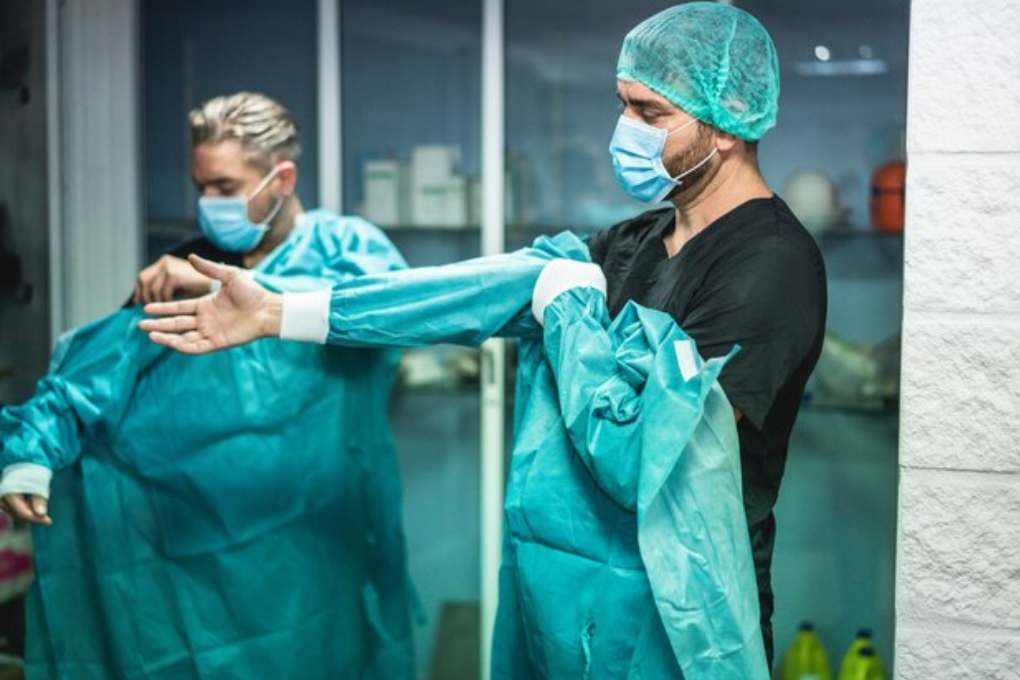Doctors wearing green clothes during surgery is a common sight that we have all become accustomed to. But have you ever wondered why they opt for this particular color? Is it simply a matter of preference, or is there something more behind this choice? Join us as we delve into the fascinating history and science behind the practice of doctors donning green attire in the operating room. Prepare to be amazed by the intriguing theories, scientific evidence, and potential benefits that come with this seemingly simple wardrobe decision! So let’s scrub in and explore the reasons behind doctors wearing green clothes during surgery.
The history of surgical attire and its evolution over time
The history of surgical attire is a fascinating journey that reflects the evolution of medicine and our understanding of hygiene in the operating room. In ancient times, surgeons didn’t have specialized clothing for surgeries. They would simply wear their regular clothes, which often weren’t very clean or sterile.

However, as medical knowledge advanced and our understanding of infection control improved, the need for proper surgical attire became evident. In the late 19th century, renowned surgeon Joseph Lister introduced antiseptic techniques to reduce postoperative infections. This included wearing clean and sterilized garments during surgery.
Initially, white was the color of choice for surgical attire because it symbolized cleanliness and purity. Surgeons wore long coats with high collars to protect themselves from contamination. However, maintaining pristine whiteness proved challenging in an environment prone to blood splatters and stains.
As technology progressed and material science improved, surgical attire evolved further. Disposable gowns made from non-woven fabrics were introduced in the mid-20th century. These gowns provided better protection against bacteria while also being more comfortable for surgeons to wear during long procedures.
Over time, different colors started appearing in surgical attire options based on practicality rather than symbolism alone. Green became popular due to its contrast with red (the color of blood), making it easier for surgeons to differentiate between tissues during intricate procedures.
Today’s modern surgical attire is designed with functionality in mind—lightweight materials that allow flexibility and easy movement while still providing adequate protection against contamination.
The history of surgical attire showcases how medical practices have continually adapted to prioritize patient safety through advancements in hygiene protocols and protective clothing choices for healthcare professionals.
The theory behind why doctors wear green during surgeries
The theory behind why doctors wear green during surgeries is an interesting one. It dates back to the early days of surgical practice, when surgeons would perform operations in their regular clothes, often stained with blood and other bodily fluids. As medicine evolved and hygiene became a priority, the need for a more sterile environment arose.
Green was chosen as the color for surgical attire because it provides a high contrast against red, which is commonly seen during surgery due to blood. This contrast allows surgeons to have better visibility of the surgical field and distinguish different tissues and structures more easily. Green also has a calming effect on the eyes, reducing eye strain during long procedures.

Furthermore, green is believed to be psychologically soothing and comforting for both patients and medical staff. It creates an atmosphere of serenity in what can be a stressful environment. This color association may help patients feel more at ease before going under anesthesia.
In addition to its visual benefits, green clothing used in surgery is typically made from lightweight and breathable materials that allow for better temperature regulation. Surgeons spend hours standing under bright lights while performing intricate procedures, so comfort plays an important role in their performance.
The theory behind why doctors wear green during surgeries revolves around practicality, visibility, psychological impact, and patient comfort. While some might argue that any color could serve these purposes equally well or even better than green does, it remains widely accepted as standard operating room attire across many healthcare facilities worldwide.
Scientific evidence supports the use of green clothing in surgery
Scientific evidence plays a crucial role in supporting the use of green clothing in surgery. Studies have shown that the color green has unique properties that make it ideal for surgical attire.
The ability of green clothing to contrast with blood’s red color is one reason why surgeons favor it. This contrast helps surgeons easily differentiate between different tissues and organs, enhancing their precision during procedures.

Research has also found that the human eye is most sensitive to shades of green, making it easier for surgeons to focus on their work without straining their eyes. Green clothing creates a calming effect on both the surgeon and the patient, reducing anxiety levels and promoting a more relaxed environment in the operating room.
Additionally, studies have demonstrated that wearing green clothing can improve concentration and attention to detail among surgeons. The color’s association with nature may evoke feelings of calmness and tranquility, allowing doctors to maintain a clear mind during complex surgeries.
Furthermore, research suggests that patients perceive doctors wearing green as more competent and trustworthy compared to other colors. This positive perception can contribute to better doctor-patient communication and ultimately lead to improved patient outcomes.
Scientific evidence supports the use of green clothing in surgery due to its visual contrast, calming effect, improvement in concentration, and positive patient perception. These findings underscore why many hospitals continue to adhere to this long-standing tradition in surgical attire.
Benefits of wearing green for surgeons and patients
Wearing green attire during surgeries has proven to provide several benefits for both surgeons and patients.
The color green is known to have a calming effect on individuals. This can be especially beneficial in high-stress surgical environments where precision and focus are crucial. When surgeons wear green clothing, it helps create a serene atmosphere that promotes concentration and reduces anxiety.

The use of green attire enhances visibility and contrast during surgery. The human eye perceives green as one of the brightest colors, making it easier for surgeons to distinguish fine details and differentiate between tissues. This improved visual perception ultimately leads to more accurate procedures and better patient outcomes.
Additionally, wearing green clothing can minimize eye strain for both the surgeon and their assisting staff. The bright hue helps reduce glare from surgical lights, allowing medical professionals to work comfortably for extended periods without experiencing undue fatigue or discomfort.
Moreover, research suggests that patients may experience psychological benefits when they see their doctors dressed in green during surgery. The color’s association with nature often evokes feelings of trustworthiness, safety, and healing—qualities that are essential in building rapport with patients.
The benefits of wearing green attire in surgery extend beyond mere tradition or personal preference. From creating a calm environment to improving visibility and enhancing patient comfort levels, there’s no denying that this practice holds value in the operating room setting!
Other colors used in surgical attire and their significance
In addition to the ubiquitous green scrubs worn by surgeons, other colors can be seen in surgical attire. These colors add variety and serve specific purposes. Let’s take a closer look at some of these colors and their significance.
One common color used in surgical attire is blue. Blue has been shown to have a calming effect on both patients and medical staff. It creates an atmosphere of tranquility and helps reduce anxiety during surgery. This soothing hue is believed to promote focus, concentration, and clear thinking among surgeons.

White is another color frequently seen in the operating room. White symbolizes purity, cleanliness, and sterility—all essential qualities for successful surgeries. Additionally, white allows any contaminants or stains to be easily spotted, ensuring strict infection control measures are followed.
Pink scrubs have become popular among pediatric surgeons as they help create a friendly environment for young patients. The cheerful nature of pink can alleviate fear and make children feel more comfortable during their medical procedures.
Some hospitals use different colored scrubs to signify various roles within the surgical team. For example, nurses might wear purple scrubs while technicians don green ones. This color-coding system helps distinguish between different healthcare professionals quickly.
It’s important to note that while these colors may serve practical purposes or have psychological effects, it’s ultimately up to each hospital or institution to determine which colors are appropriate for their surgical attire policies.
The use of various colored scrubs adds diversity and personalization within the sterile environment of an operating room while maintaining the professionalism and functionality required for successful surgeries!
Also, check out “The Benefits of Brain Fitness Exercises” for some great advice on how to keep your mind sharp and healthy.




